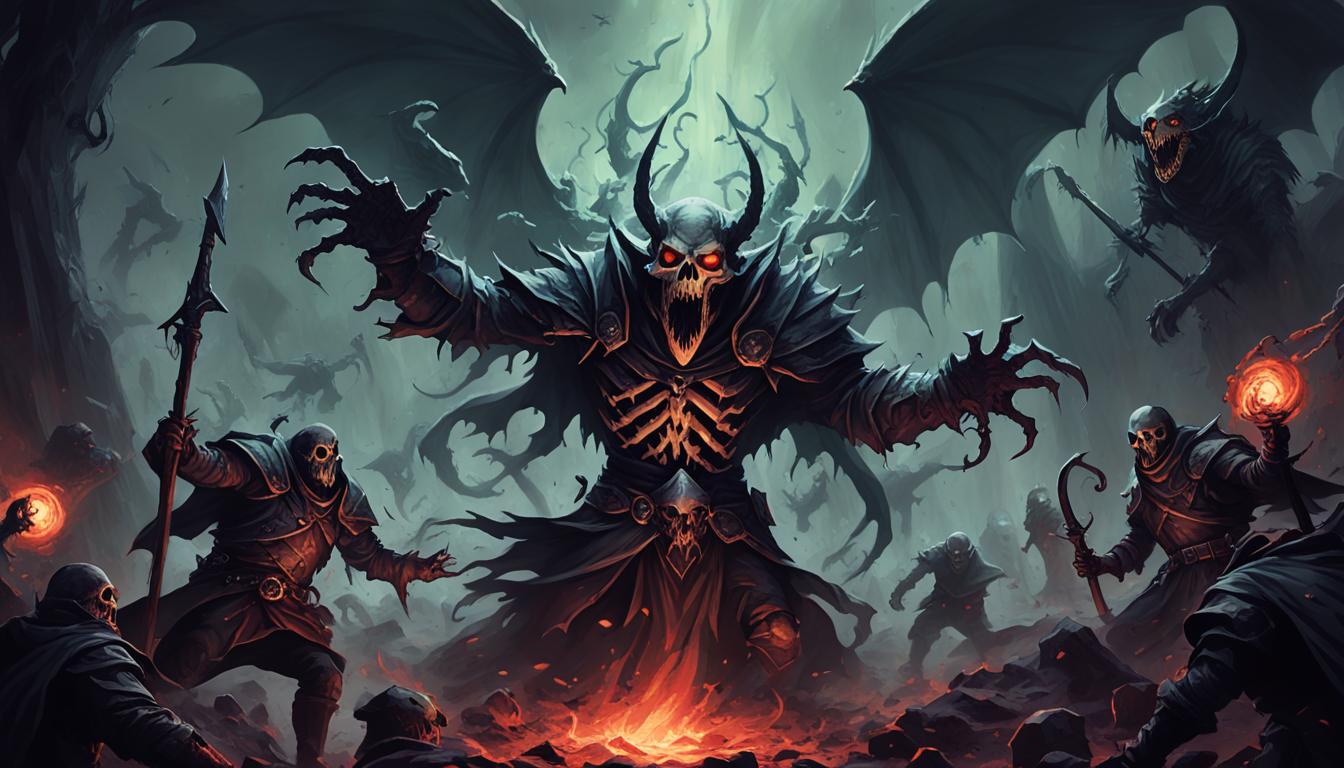Necrotic Damage 5e: Deadly Debuffs in D&D Fifth Edition
Necrotic Damage is a serious threat you face in Dungeons & Dragons Fifth Edition (5e). It plays a big part in how battles and story encounters unfold. To face it, you must know what Necrotic Damage does, and how to deal with it. We’ll explore this mechanic deeply.

Key Takeaways:
- Necrotic Damage is a deadly debuff mechanic in D&D 5e.
- It represents the decay and deterioration of living organisms.
- Necrotic Damage can drain life force and corrupt the soul of the target.
- Understanding Necrotic Damage is essential for both players and Dungeon Masters.
- Countering Necrotic Damage requires strategic spell selection and protective measures.
Understanding Necrotic Damage in D&D
In Dungeons & Dragons, Necrotic Damage is both eerie and intriguing. It stands for the decay of life. This type of damage drains energy, causes tissue decay, and affects the soul.
What is Necrotic Damage?
Necrotic Damage focuses on the dark aspects of magic and life. It embodies decay and is wielded by necromancers and undead. This sinister power drains life energy and can corrupt the soul.
When life is drained from a being by Necrotic Damage, it causes both physical and metaphysical harm. The result can be lasting and may weaken the victim’s very essence.
Necrotic Damage Mechanics and Effects
The workings of Necrotic Damage aim to cause chaos among the living. Those hit by it feel its immediate corruptive influence. The damage’s severity varies, influenced by the attack and its source.
This type of damage can have several effects. It weakens the victim, making them more vulnerable. It can also decay tissues, or even affect the soul if the power behind the damage is strong enough.
Interplaying with Game Mechanics and Storytelling
Understanding Necrotic Damage is key for both players and Dungeon Masters. It adds depth to combat and challenges. Fighters of this type can exploit foes’ weaknesses or harm their bodies.
From a storytelling angle, Necrotic Damage can set a dark tone. It makes the game tense and engages players in the story. The aftermath of this damage can also be a key point for character growth and story development.

As you dig into Necrotic Damage, you find new ways for creativity and story shaping. It could be a healer fighting the decay or a necromancer using it as a weapon. This aspect brings thrilling possibilities to adventures.
Necrotic Damage 5e
In the 5th Edition of Dungeons & Dragons, Necrotic Damage is a well-known concept. It appears in spells, abilities, and attacks. Knowing how Necrotic Damage works is key for both players and Game Masters.
Necrotic Damage represents decay and corruption’s destructive force. It’s linked to dark magic, negative energy, and the undead. When hit, a creature’s life force can fade, its body can wither, and its soul might get darkened.
Necrotic Damage has a unique trait in 5e. It can get past some resistances and is very effective against specific targets. This makes it a strong choice in battle for both heroes and monsters.
Now, let’s dive into some spells and abilities with Necrotic Damage:
- Finger of Death is a potent spell. It sends pure necrotic energy at a target. This can kill them and make them serve as undead.
- Life Drain is an ability of the undead. It lets them suck the life out of others. This deals Necrotic Damage and can heal the undead user.
- Inflict Wounds is a spell. It thrusts a burst of necrotic power into a target. This causes heavy damage and can cripple them.
Knowing Necrotic Damage well is important for a fun D&D game. Whether you wield its power or set up challenging fights, understanding Necrotic Damage boosts your game.

Countering Necrotic Damage: Strategies and Spells
Fighting against Necrotic Damage is tough, but there are ways to lessen its harm. It can drain life, decay body tissues, or darken a soul. Players can use the strategies and spells below to fight back:
- Utilize Protective Spells: Protection from Energy and Death Ward are great defenses. They give resistance or even block Necrotic Damage, keeping your character safe.
- Harness Damage Resistance: Some characters naturally resist certain damages, including Necrotic. Choose wisely or enhance your abilities to fight Necrotic Damage with less harm.
- Equip Necrotic Damage-Resistant Items: In Dungeons & Dragons, you can find items like the Amulet of Necrotic Resistance. Equipping these special items boosts your survival against Necrotic threats.
- Seek Divine Assistance: Clerics and Paladins offer help from the divine against Necrotic Damage. Spells like Heal and Greater Restoration can mend wounds and clear Necrotic effects.
- Collaborate with Allies: Working with your party is key. Together, make sure everyone uses their unique skills to protect, heal, or enhance each other.
- Engage in Tactical Combat: Learn how Necrotic Damage works to fight it better. Smart positioning and knowing your enemy’s weaknesses can turn the tide in battle.
By using these strategies and the right spells, adventurers can beat Necrotic Damage. They can win tough battles against evil forces.
Creative Utilization of Necrotic Damage by Spellcasters
Being a spellcaster in Dungeons & Dragons means you can do cool things with Necrotic Damage. You can mix spells in smart ways to do more damage. This makes you powerful in battles.
Maximizing Damage: Spell Selection and Combination
To use Necrotic Damage well, choosing the right spells is crucial. Pick spells that cause Necrotic Damage or work well with it. For instance, “Vampiric Touch” and “Inflict Wounds” are great for this.
Role-Playing the Effects of Necrotic Damage in Your Campaign
Necrotic Damage isn’t just about numbers and fighting. It’s a chance to make your character’s story more interesting. Imagine how your character’s spells look and feel.
For instance, when you cast a Necrotic Damage spell, you could say shadows surround your target. Or, you might feel a cold wind as you cast your spell. Also, think about how your character’s story affects how they use Necrotic Damage.
This role-playing part can make your game come alive. It adds fun and makes stories that you and your friends will remember. It deepens your campaign’s story.
By choosing spells wisely and making the most of Necrotic Damage, spellcasters can change a game. Try different things and see how powerful Necrotic spells can be. They can make your story stand out and your enemies fear you.
The Challenge of Necrotic Damage for Dungeon Masters
As a Dungeon Master, handling Necrotic Damage can be extra tricky. Adding this deadly feature to fights needs thoughtful planning. It’s to keep the battles fun and fair for everyone.
Necrotic Damage is serious. It can weaken or even change a character’s soul. Knowing how this works is key to making the game feel real and exciting.
To bring Necrotic Damage into your games, here are some ideas:
- Include monsters that can use Necrotic Damage. This makes fights more varied and challenging.
- Find new ways to talk about Necrotic Damage. It adds fear and excitement to the game.
- Let players find ways to fight back against Necrotic Damage. This rewards smart play and keeps things interesting.
- Think about what your players are strong or weak against. Fair fights make the game more fun for everyone.
- Make Necrotic Damage part of your game’s bigger story. Players will love finding out more about it, adding a new layer to their adventure.
By using these tips, you can make games that players will remember. They’ll see the danger of Necrotic Damage while having a great time. Always talk to your players to keep the game fair and fun.

Necrotic Damage Resistance and Immunity
In Dungeons & Dragons, adventurers often face Necrotic Damage, a dangerous threat. Some beings can resist or ignore this dark energy altogether. Knowing about resistance and immunity in the 5th edition can change how you play and build your character.
Understanding Resistance Mechanics in 5e
Necrotic Damage resistance means you take less harm from Necrotic attacks. Those resistant take only half damage. For instance, if you get 10 points of Necrotic Damage, you’d actually take 5 points. This can be key in fighting foes with strong Necrotic powers.
Monsters and Characters with Natural Resistances
Certain D&D monsters and characters naturally resist Necrotic Damage. This could be because of their type, like Undead creatures who often resist it. Some races and classes, such as Half-Orcs and Oath of Conquest Paladins, also naturally resist this damage.
| Monster/Character | Resistance |
|---|---|
| Lich | Necrotic |
| Half-Orc | Necrotic |
| Oath of Conquest Paladin | Necrotic |
Equipment and Magic Items Granting Necrotic Immunity
Adventurers could also find items that make them immune to Necrotic Damage. Objects like the Amulet of Necrotic Immunity offer full protection. They make the wearer impervious to Necrotic attacks.
Knowing about Necrotic Damage resistance and immunity is vital in character growth and battles. These skills are crucial for both using and facing Necrotic powers in Dungeons & Dragons.
Conclusion In D&D 5e, Necrotic Damage is a key mechanic that makes battles more challenging. It adds an element that affects both players and the storyteller. Knowing how Necrotic Damage works makes the game more interesting for everyone involved.
Necrotic Damage changes how fights happen. It can drain life, decay bodies, or harm the soul. This makes players and Dungeon Masters think more strategically. They have to plan carefully to handle or use Necrotic Damage well, making the game more engaging.
Using Necrotic Damage wisely is crucial. It should fit naturally in the story and game world. Knowing about it can help both players and Dungeon Masters create unforgettable game moments. So, don’t fear Necrotic Damage. Instead, use it to make your D&D adventures better than ever.